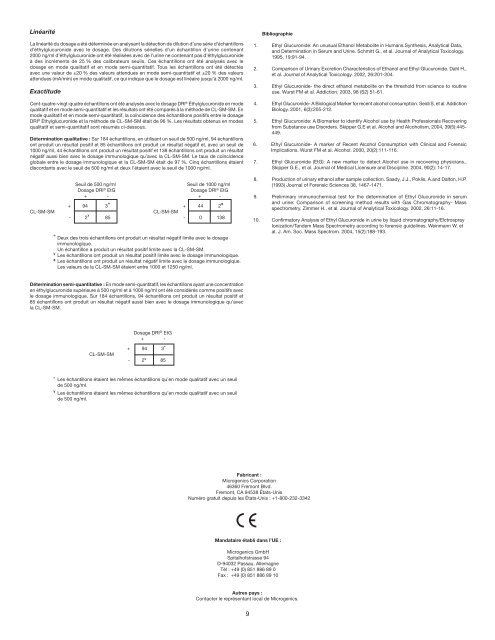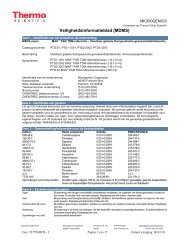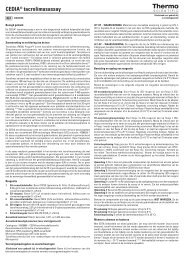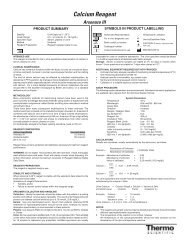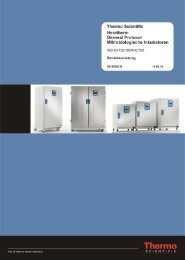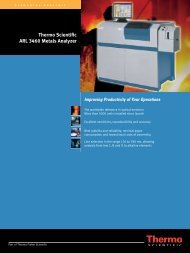DRI® Ethyl Glucuronide Assay - Fisher Scientific
DRI® Ethyl Glucuronide Assay - Fisher Scientific
DRI® Ethyl Glucuronide Assay - Fisher Scientific
Create successful ePaper yourself
Turn your PDF publications into a flip-book with our unique Google optimized e-Paper software.
Linéarité<br />
La linéarité du dosage a été déterminée en analysant la détection de dilution d’une série d’échantillons<br />
d’éthylglucuronide avec le dosage. Des dilutions sérielles d’un échantillon d’urine contenant<br />
2000 ng/ml d’éthylglucuronide ont été réalisées avec de l’urine ne contenant pas d’éthylglucuronide<br />
à des incréments de 25 % des calibrateurs seuils. Ces échantillons ont été analysés avec le<br />
dosage en mode qualitatif et en mode semi-quantitatif. Tous les échantillons ont été détectés<br />
avec une valeur de ±20 % des valeurs attendues en mode semi-quantitatif et ±20 % des valeurs<br />
attendues (mA/min) en mode qualitatif, ce qui indique que le dosage est linéaire jusqu’à 2000 ng/ml.<br />
Exactitude<br />
Cent-quatre-vingt-quatre échantillons ont été analysés avec le dosage DRI ® Éthylglucuronide en mode<br />
qualitatif et en mode semi-quantitatif et les résultats ont été comparés à la méthode de CL-SM-SM. En<br />
mode qualitatif et en mode semi-quantitatif, la coïncidence des échantillons positifs entre le dosage<br />
DRI ® Éthylglucuronide et la méthode de CL-SM-SM était de 96 %. Les résultats obtenus en modes<br />
qualitatif et semi-quantitatif sont résumés ci-dessous.<br />
Détermination qualitative : Sur 184 échantillons, en utilisant un seuil de 500 ng/ml, 94 échantillons<br />
ont produit un résultat positif et 85 échantillons ont produit un résultat négatif et, avec un seuil de<br />
1000 ng/ml, 44 échantillons ont produit un résultat positif et 138 échantillons ont produit un résultat<br />
négatif aussi bien avec le dosage immunologique qu’avec la CL-SM-SM. Le taux de coïncidence<br />
globale entre le dosage immunologique et la CL-SM-SM était de 97 %. Cinq échantillons étaient<br />
discordants avec le seuil de 500 ng/ml et deux l’étaient avec le seuil de 1000 ng/ml.<br />
Seuil de 500 ng/ml Seuil de 1000 ng/ml<br />
Dosage DRI ® EtG Dosage DRI ® EtG<br />
+ - + -<br />
+ 94 3 * + 44 2 ♠<br />
CL-SM-SM CL-SM-SM<br />
- 2 ¥ 85 - 0 138<br />
* Deux des trois échantillons ont produit un résultat négatif limite avec le dosage<br />
immunologique.<br />
Un échantillon a produit un résultat positif limite avec la CL-SM-SM.<br />
¥ Les échantillons ont produit un résultat positif limite avec le dosage immunologique.<br />
♠ Les échantillons ont produit un résultat négatif limite avec le dosage immunologique.<br />
Les valeurs de la CL-SM-SM étaient entre 1000 et 1250 ng/ml.<br />
Détermination semi-quantitative : En mode semi-quantitatif, les échantillons ayant une concentration<br />
en éthylglucuronide supérieure à 500 ng/ml et à 1000 ng/ml ont été considérés comme positifs avec<br />
le dosage immunologique. Sur 184 échantillons, 94 échantillons ont produit un résultat positif et<br />
85 échantillons ont produit un résultat négatif aussi bien avec le dosage immunologique qu’avec<br />
la CL-SM-SM.<br />
CL-SM-SM<br />
Dosage DRI ® EtG<br />
+ -<br />
+ 94 3*<br />
- 2 ¥ 85<br />
* Les échantillons étaient les mêmes échantillons qu’en mode qualitatif avec un seuil<br />
de 500 ng/ml.<br />
¥ Les échantillons étaient les mêmes échantillons qu’en mode qualitatif avec un seuil<br />
de 500 ng/ml.<br />
9<br />
Bibliographie<br />
Fabricant :<br />
Microgenics Corporation<br />
46360 Fremont Blvd.<br />
Fremont, CA 94538 États-Unis<br />
Numéro gratuit depuis les États-Unis : +1-800-232-3342<br />
Mandataire établi dans l’UE :<br />
Microgenics GmbH<br />
Spitalhofstrasse 94<br />
D-94032 Passau, Allemagne<br />
Tél : +49 (0) 851 886 89 0<br />
Fax : +49 (0) 851 886 89 10<br />
Autres pays :<br />
Contacter le représentant local de Microgenics.<br />
1. <strong>Ethyl</strong> <strong>Glucuronide</strong>: An unusual Ethanol Metabolite in Humans.Synthesis, Analytical Data,<br />
and Determination in Serum and Urine. Schmitt G., et al. Journal of Analytical Toxicology.<br />
1995, 19:91-94.<br />
2. Comparison of Urinary Excretion Characteristics of Ethanol and <strong>Ethyl</strong> <strong>Glucuronide</strong>. Dahl H.,<br />
et al. Journal of Analytical Toxicology. 2002, 26:201-204.<br />
3. <strong>Ethyl</strong> <strong>Glucuronide</strong>- the direct ethanol metabolite on the threshold from science to routine<br />
use. Wurst FM et al. Addiction. 2003, 98 (S2) 51-61.<br />
4. <strong>Ethyl</strong> <strong>Glucuronide</strong>- A Biological Marker for recent alcohol consumption. Seidi S. et al. Addiction<br />
Biology. 2001, 6(3):205-212.<br />
5. <strong>Ethyl</strong> <strong>Glucuronide</strong>: A Biomarker to identify Alcohol use by Health Professionals Recovering<br />
from Substance use Disorders. Skipper G.E et al. Alcohol and Alcoholism, 2004, 39(5):445-<br />
449.<br />
6. <strong>Ethyl</strong> <strong>Glucuronide</strong>- A marker of Recent Alcohol Consumption with Clinical and Forensic<br />
Implications. Wurst FM et al. Alcohol. 2000, 20(2):111-116.<br />
7. <strong>Ethyl</strong> <strong>Glucuronide</strong> (EtG): A new marker to detect Alcohol use in recovering physicians.,<br />
Skipper G.E., et al. Journal of Medical Licensure and Discipline. 2004, 90(2): 14-17.<br />
8. Production of urinary ethanol after sample collection. Saady, J.J., Poklis, A.and Dalton, H.P.<br />
(1993) Journal of Forensic Sciences 38, 1467-1471.<br />
9. Preliminary immunochemical test for the determination of <strong>Ethyl</strong> <strong>Glucuronide</strong> in serum<br />
and urine: Comparison of screening method results with Gas Chromatography- Mass<br />
spectrometry. Zimmer H., et al. Journal of Analytical Toxicology. 2002, 26:11-16.<br />
10. Confirmatory Analysis of <strong>Ethyl</strong> <strong>Glucuronide</strong> in urine by liquid chromatography/Elctrospray<br />
Ionization/Tandem Mass Spectrometry according to forensic guidelines. Weinmann W. et<br />
al. J. Am. Soc. Mass Spectrom. 2004, 15(2):188-193.


